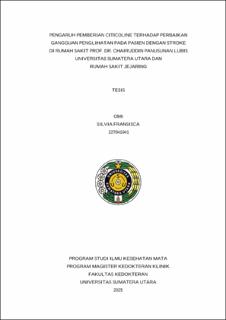Pengaruh Pemberian Citicoline terhadap Perbaikan Gangguan Penglihatan pada Pasien dengan Stroke di Rumah Sakit Prof. DR. Chairuddin Panusunan Lubis Universitas Sumatera Utara dan Rumah Sakit Jejaring
The Effect of Citicoline Administration on Visual Function Improvement in Stroke Patients at Prof. DR. Chairuddin Panusunan Lubis Hospital, University Of Sumatera Utara, and Affiliated Network Hospitals

Date
2025Author
Fransisca, Silvia
Advisor(s)
Sari, Masitha Dewi
Aldy, Fithria
Metadata
Show full item recordAbstract
Background: Visual disturbances are a common and often debilitating complication
following stroke, significantly impairing patients’ functional independence and quality of
life. Among various neuroprotective agents, Citicoline (cytidine-5’-diphosphocholine) has
demonstrated multifaceted mechanisms of action, including modulation of phospholipid
metabolism, reduction of oxidative stress, and enhancement of dopaminergic and
cholinergic neurotransmission. These properties suggest potential benefits in promoting
visual recovery post-stroke. Methods: This quasi-experimental study employed a pre- and
post-intervention design involving 30 post-stroke patients who received 1000 mg of oral
Citicoline daily for 30 consecutive days. Visual function was evaluated through standard
ophthalmological assessments, including visual acuity (logMAR), visual field analysis
using the Humphrey Field Analyzer, contrast sensitivity (Pelli-Robson chart), and color
sensitivity test (Farnsworth Munsell D-15 test), both before and after treatment.
Results: Post-treatment analysis revealed no statistically significant improvement in
visual acuity or visual field parameters (p > 0.05). However, contrast sensitivity showed a
statistically significant enhancement following Citicoline administration (p < 0.05). No
significant changes were observed in color vision outcomes (p > 0.05). Conclusion: Oral
Citicoline supplementation over a 30-day period appears to exert a beneficial effect
specifically on contrast sensitivity in stroke patients with visual dysfunction, while its
impact on visual acuity, visual fields, and color perception remains inconclusive. Further
research involving combinations with other neuroprotective agents, larger sample sizes,
or longer intervention durations is needed to confirm these findings and to explore the
potential benefits of Citicoline more comprehensively.
